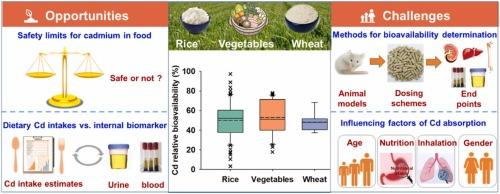基于食品中镉生物利用度的膳食镉暴露健康风险评估:机遇与挑战
IF 11.3
1区 环境科学与生态学
Q1 ENGINEERING, ENVIRONMENTAL
引用次数: 0
摘要
通过受污染的食物长期接触Cd可对人类健康造成多种不利影响。虽然以前的研究涵盖了全球食物Cd浓度和不同人群的饮食Cd暴露情况,但人们越来越关注目前的食品Cd安全标准是否足以保护人群免受不利的健康影响。此外,在食品中加入Cd相对生物利用度(Cd- rba)可提高健康风险评估的准确性。然而,影响食品Cd-RBA的因素尚未得到系统的讨论,从而阻碍了其在风险评估中的应用。本文综述了食品中Cd含量的概况,讨论了国际食品Cd浓度标准的关注问题,探讨了影响食品Cd生物利用度的因素,并强调了改善膳食Cd摄入量和身体负担之间差异的机遇和挑战。我们的研究结果表明,目前的安全标准可能不足以保护人类健康,因为它们主要关注肾脏损伤作为保护终点,而未能考虑到全球和地区的食物消费模式差异以及饮食习惯随时间的变化。作物品种和食物成分等因素对食物Cd-RBA影响很大。为了提高Cd健康风险评估的准确性,未来的研究应纳入食物Cd- rba、社会人口特征、营养状况和偶然的Cd暴露。本综述强调了对食品Cd安全标准和Cd生物利用度的新见解,确定了关键的知识空白,并提出了改进健康风险评估的建议。这些信息对未来的生物利用度调查、健康风险评估和安全标准制定至关重要。本文章由计算机程序翻译,如有差异,请以英文原文为准。

Health risk assessment of dietary cadmium exposure based on cadmium bioavailability in food: Opportunities and challenges
Long-term exposure to Cd through contaminated food can lead to multiple adverse health effects on humans. Although previous studies have covered global food Cd concentrations and dietary Cd exposures across different populations, there are increasing concerns regarding the adequacy of current food Cd safety standards to protect populations from adverse health effects. Moreover, incorporation of Cd relative bioavailability (Cd-RBA) in foods improves the accuracy of health risk assessment. However, factors influencing food Cd-RBA have not been systematically discussed, thereby hindering its application in risk assessment. This review aims to provide an overview of Cd contents in foods, discuss concerns regarding international food Cd concentration standards, explore factors influencing food Cd bioavailability, and highlight the opportunities and challenges in refining differences between dietary Cd intakes and body burdens. Our findings suggest that current safety standards may be insufficient to protect human health, as they primarily focus on kidney damage as the protective endpoint and fail to account for global and regional variations in food consumption patterns and temporal changes in dietary habits over time. Factors such as crop cultivars and food compositions greatly influence food Cd-RBA. To improve the accuracy of Cd health risk assessment, future studies should incorporate food Cd-RBA, sociodemographic characteristics, nutritional status, and incidental Cd exposure. This review highlights new insights into food Cd safety standards and Cd bioavailability, identifies critical knowledge gaps, and offers recommendations for refining health risk assessments. This information is essential to inform future bioavailability investigations, health risk assessment, and safety standard development.
求助全文
通过发布文献求助,成功后即可免费获取论文全文。
去求助
来源期刊

Journal of Hazardous Materials
工程技术-工程:环境
CiteScore
25.40
自引率
5.90%
发文量
3059
审稿时长
58 days
期刊介绍:
The Journal of Hazardous Materials serves as a global platform for promoting cutting-edge research in the field of Environmental Science and Engineering. Our publication features a wide range of articles, including full-length research papers, review articles, and perspectives, with the aim of enhancing our understanding of the dangers and risks associated with various materials concerning public health and the environment. It is important to note that the term "environmental contaminants" refers specifically to substances that pose hazardous effects through contamination, while excluding those that do not have such impacts on the environment or human health. Moreover, we emphasize the distinction between wastes and hazardous materials in order to provide further clarity on the scope of the journal. We have a keen interest in exploring specific compounds and microbial agents that have adverse effects on the environment.
 求助内容:
求助内容: 应助结果提醒方式:
应助结果提醒方式:


